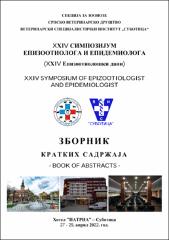Primena koncepta "Jedno zdravlje" - šanse i prednosti

View/
Date
2022-04-27Author
Nedić, Drago
Petrović, Tamaš
Rodić Vukmir, Nina
Dimitrijević, Dragana
Đurić, Boban
Toplak, Ivan
Cvetnić, Željko
Metadata
Show full item recordAbstract
Nearly two-thirds of human pathogens come from domestic and wild animals, known
as zoonoses. Many diseases pose a risk to public health around the world and it is
therefore imperative that these diseases be eradicated locally and globally. The
concept of "One Health" is based on awareness of the need to protect public health,
acting primarily on the prevention and control of pathogens within human and animal
populations in the environment in which they live.
The concept of "One Health" began to be applied after the signing of a joint document
between the World Health Organization (WHO), the World Organization for Animal
Health (RES) and the Food and Agriculture Organization of the United Nations
(FAO). This document sets out mutual responsibilities and goals in this area. From
the very beginning, the priority topics for joint action were: the rabies virus, which
kills over 59,000 people a year, and other zoonotic viruses such as bird flu.
Antimicrobial resistance is one of the first priorities. All necessary activities of experts
in the field of animal health, public health and the environment should be implemented
at the local, national and global levels. This should contribute to the continuous and
simultaneous improvement of public health, animal health and environmental
protection worldwide.
The most efficient and economical solution for human protection is the fight against
all zoonotic pathogens in the animal population. This requires a strategic approach,
organization, management and control with adequate investment of financial
resources and engagement of available human and material resources from both the
public and private sectors. This means establishing new mechanisms for mutual
information and synchronized joint action. Pathogens that are not zoonoses, but have
an indirect negative impact on health, food production and the environment, should
certainly be taken into account. All three international organizations publish standards
and recommendations on how to act in certain circumstances that are helpful to the
competent decision-making institutions.Despite the fact that the concept of "One Health" was established a few decades ago,
there is no change in policy in this regard. Very few countries have adopted a strategy
based on the concept of "One Health", i.e. some countries have done very little while
a huge number of countries have done nothing. All this can be explained by the
appearance of the COVID 19 pandemic, which has been going on for more than two
years, with many unclear situations such as the origin of the virus, mutations,
diagnostics and vaccinations. It is a devastating fact that the involvement of veterinary
institutions during the pandemic period was quite unnoticed. In some countries,
commissions or ad-hoc working groups on zonoses have been established, but there
has been no systematic approach to the concept of "One Health".
This paper presents different experiences of individual countries in the occurrence of
certain diseases such as COVID 19, rabies and bird flu in the region, as well as
experiences in the control of antimicrobial resistance. The aim of this paper is to point
out the advantages and opportunities in the application of the concept of "One Health",
the good and bad experiences at the local, regional and global levels.
